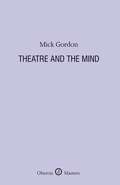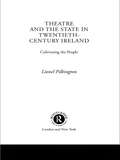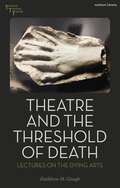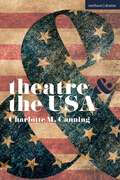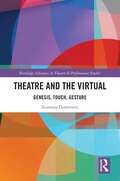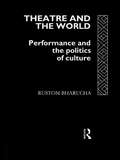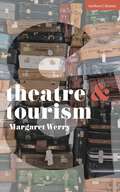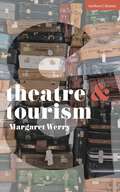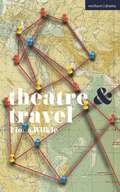- Table View
- List View
Theatre and the Digital (Theatre And)
by Bill BlakeWhy should the digital bring about ideas of progress in the theatre arts? This question opens up a rich seam of provocative and original thinking about the uses of new media in theatre, about new forms of cultural practice and artistic innovation, and about the widening purposes of the theatre's cultural project in a changing digital world. Through detailed case-studies on the work of key international theatre companies such as the Elevator Repair Service and The Mission Business, Bill Blake explores how the digital is providing new scope for how we think about the theatre, as well as how the theatre in turn is challenging how we might relate to the digital.
Theatre and the Digital (Theatre And)
by Bill BlakeWhy should the digital bring about ideas of progress in the theatre arts? This question opens up a rich seam of provocative and original thinking about the uses of new media in theatre, about new forms of cultural practice and artistic innovation, and about the widening purposes of the theatre's cultural project in a changing digital world. Through detailed case-studies on the work of key international theatre companies such as the Elevator Repair Service and The Mission Business, Bill Blake explores how the digital is providing new scope for how we think about the theatre, as well as how the theatre in turn is challenging how we might relate to the digital.
Theatre and the Mind (Oberon Masters Series)
by Mick GordonIn this collection of seven provocative essays, acclaimed theatre director and playwright Mick Gordon argues that the theatre represents a physical corollary of the invisible workings of our minds.In this publication the award-winning Gordon draws upon his five years experience working with leading neurologists and cognitive psychologists, a period during which he produced two plays exploring the neurological basis of identity and emotion. Gordon contends that the narratives and archetypes common to the theatre reflect the hidden paradigms of our minds, and that theatrical exploration echos our subconscious urge for morality.
Theatre and the State in Twentieth-Century Ireland: Cultivating the People
by Lionel PilkingtonThis major new study presents a political and cultural history of some of Ireland's key national theatre projects from the 1890s to the 1990s. Impressively wide-ranging in coverage, Theatre and the State in Twentieth-Century Ireland: Cultivating the People includes discussions on: *the politics of the Irish literary movement at the Abbey Theatre before and after political independence; *the role of a state-sponsored theatre for the post-1922 unionist government in Northern Ireland; *the convulsive effects of the Northern Ireland conflict on Irish theatre. Lionel Pilkington draws on a combination of archival research and critical readings of individual plays, covering works by J. M. Synge, Sean O'Casey, Lennox Robinson, T. C. Murray, George Shiels, Brian Friel, and Frank McGuinness. In its insistence on the details of history, this is a book important to anyone interested in Irish culture and politics in the twentieth century.
Theatre and the State in Twentieth-Century Ireland: Cultivating the People
by Lionel PilkingtonThis major new study presents a political and cultural history of some of Ireland's key national theatre projects from the 1890s to the 1990s. Impressively wide-ranging in coverage, Theatre and the State in Twentieth-Century Ireland: Cultivating the People includes discussions on: *the politics of the Irish literary movement at the Abbey Theatre before and after political independence; *the role of a state-sponsored theatre for the post-1922 unionist government in Northern Ireland; *the convulsive effects of the Northern Ireland conflict on Irish theatre. Lionel Pilkington draws on a combination of archival research and critical readings of individual plays, covering works by J. M. Synge, Sean O'Casey, Lennox Robinson, T. C. Murray, George Shiels, Brian Friel, and Frank McGuinness. In its insistence on the details of history, this is a book important to anyone interested in Irish culture and politics in the twentieth century.
Theatre and the Threshold of Death: Lectures on the Dying Arts (Thinking Through Theatre)
by Kathleen GoughOn the eve of a global pandemic, Kathleen Gough, a theatre professor, becomes immersed in the lives of five artist-mystics, each of whom is a pioneer in her field: Hildegard of Bingen (1098-1179), the first known musical composer; Eleanora Duse (1858-1924), the first modern actor in the Western world; Simone Weil (1909-1943), philosopher, activist, and mystic, whom Albert Camus called “the only great spirit of our time”; Marina Abramovic (b. 1946), “the grandmother of performance art”; and Hilma af Klint (1862-1944), the first known (and belatedly acknowledged) abstract painter. Each time Gough crosses a threshold into their world, she is compelled to attend courses, seminars and workshops that are simultaneously about dying and healing.Curious to learn more about the relationships between art practice, dying, and healing, Gough imagines the five artists as wisdom teachers in a mystery school. In a series of eight lectures, she turns to performance theory to provide a framework for engaging with the unknown world. In Theatre and the Threshold of Death, Gough makes a persuasive argument for the world-making power of relational thinking in our increasingly polarized age.
Theatre and the Threshold of Death: Lectures on the Dying Arts (Thinking Through Theatre)
by Kathleen GoughOn the eve of a global pandemic, Kathleen Gough, a theatre professor, becomes immersed in the lives of five artist-mystics, each of whom is a pioneer in her field: Hildegard of Bingen (1098-1179), the first known musical composer; Eleanora Duse (1858-1924), the first modern actor in the Western world; Simone Weil (1909-1943), philosopher, activist, and mystic, whom Albert Camus called “the only great spirit of our time”; Marina Abramovic (b. 1946), “the grandmother of performance art”; and Hilma af Klint (1862-1944), the first known (and belatedly acknowledged) abstract painter. Each time Gough crosses a threshold into their world, she is compelled to attend courses, seminars and workshops that are simultaneously about dying and healing.Curious to learn more about the relationships between art practice, dying, and healing, Gough imagines the five artists as wisdom teachers in a mystery school. In a series of eight lectures, she turns to performance theory to provide a framework for engaging with the unknown world. In Theatre and the Threshold of Death, Gough makes a persuasive argument for the world-making power of relational thinking in our increasingly polarized age.
Theatre and the USA (Theatre And)
by Charlotte CanningHow is the individual and the 'nation' constructed and promoted in American theatre? How does theatre enable a nation to invent and reinvent itself? Who are the 'people' in 'We the People'?This brief study examines the intersection of the USA's sense of self with its theatre, revealing how the two have an entangled history and a shared identity.Through case studies of six canonical plays and musicals, such as Uncle Tom's Cabin (1852), Oklahoma! (1943), Angels in America (1991), and Hamilton (2015), Theatre and the USA demonstrates how all six of these plays sparked controversy, spoke to their moment, and became canonical texts, arguing that that the histories of these plays are the history of the USA's theatrical infrastructure.
Theatre and the USA (Theatre And)
by Charlotte CanningHow is the individual and the 'nation' constructed and promoted in American theatre? How does theatre enable a nation to invent and reinvent itself? Who are the 'people' in 'We the People'?This brief study examines the intersection of the USA's sense of self with its theatre, revealing how the two have an entangled history and a shared identity.Through case studies of six canonical plays and musicals, such as Uncle Tom's Cabin (1852), Oklahoma! (1943), Angels in America (1991), and Hamilton (2015), Theatre and the USA demonstrates how all six of these plays sparked controversy, spoke to their moment, and became canonical texts, arguing that that the histories of these plays are the history of the USA's theatrical infrastructure.
Theatre and the Virtual: Genesis, Touch, Gesture (Routledge Advances in Theatre & Performance Studies)
by Zornitsa DimitrovaTheatre and the Virtual lays out a set of conceptual instruments for the articulation and engendering of the forces of theatrical potentiality. Creating a passage toward a reconstitution of the given, a theatre of the virtual opens bodies in motion to a region of an ongoing genesis of forces. The outcome: regimes of constraint are abandoned through a radical practice of ecological attunement. Violence is eschewed through an onto-ecology of touch. Closed systems are repotentialised to become co-constitutive of their environments. A logic of spectrality settles in—not so much entities as atmospheres, not so much a being as a style of being, not so much a body as multitudinous milieus of response. This is the task of a theatre of the virtual—to safeguard the possibility of the extra-epistemological and uphold one’s right to offer accounts of oneself from outside of being, all the while creating a fractured record of the wondrous mutations of a moving, gesturing body. This book will be of great interest to students and scholars in theatre, philosophy, new materialisms, environmental humanities, gesture, and the ontology of response.
Theatre and the Virtual: Genesis, Touch, Gesture (Routledge Advances in Theatre & Performance Studies)
by Zornitsa DimitrovaTheatre and the Virtual lays out a set of conceptual instruments for the articulation and engendering of the forces of theatrical potentiality. Creating a passage toward a reconstitution of the given, a theatre of the virtual opens bodies in motion to a region of an ongoing genesis of forces. The outcome: regimes of constraint are abandoned through a radical practice of ecological attunement. Violence is eschewed through an onto-ecology of touch. Closed systems are repotentialised to become co-constitutive of their environments. A logic of spectrality settles in—not so much entities as atmospheres, not so much a being as a style of being, not so much a body as multitudinous milieus of response. This is the task of a theatre of the virtual—to safeguard the possibility of the extra-epistemological and uphold one’s right to offer accounts of oneself from outside of being, all the while creating a fractured record of the wondrous mutations of a moving, gesturing body. This book will be of great interest to students and scholars in theatre, philosophy, new materialisms, environmental humanities, gesture, and the ontology of response.
Theatre and the World: Performance and the Politics of Culture
by Rustom BharuchaIn this passionate and controversial work, director and critic Rustom Bharucha presents the first major critique of intercultural theatre from a 'Third World' perspective. Bharucha questions the assumptions underlying the theatrical visions of some of the twentieth century's most prominent theatre practitioners and theorists, including Antonin Artaud, Jerzsy Grotowski, and Peter Brook. He contends that Indian theatre has been grossly mythologised and taken out of context by Western directors and critics. And he presents a detailed dramaturgical analysis of what he describes as an intracultural theatre project, providing an alternative vision of the possibilities of true cultural pluralism. Theatre and the World bravely challenges much of today's 'multicultural' theatre movement. It will be vital reading for anyone interested in the creation or discussion of a truly non-Eurocentric world theatre.
Theatre and the World: Performance and the Politics of Culture
by Rustom BharuchaIn this passionate and controversial work, director and critic Rustom Bharucha presents the first major critique of intercultural theatre from a 'Third World' perspective. Bharucha questions the assumptions underlying the theatrical visions of some of the twentieth century's most prominent theatre practitioners and theorists, including Antonin Artaud, Jerzsy Grotowski, and Peter Brook. He contends that Indian theatre has been grossly mythologised and taken out of context by Western directors and critics. And he presents a detailed dramaturgical analysis of what he describes as an intracultural theatre project, providing an alternative vision of the possibilities of true cultural pluralism. Theatre and the World bravely challenges much of today's 'multicultural' theatre movement. It will be vital reading for anyone interested in the creation or discussion of a truly non-Eurocentric world theatre.
Theatre and Therapy (Theatre And)
by Fintan WalshWalsh argues that there are many links between theatre and therapy when considering actor training, theatre in therapeutic contexts, and contemporary theatre and performance. He draws on a range of examples that include the drama of Sarah Kane, the method acting of Daniel Day Lewis and performances by Ruby Wax and David Hoyle.
Theatre and Therapy (Theatre And)
by Fintan WalshWalsh argues that there are many links between theatre and therapy when considering actor training, theatre in therapeutic contexts, and contemporary theatre and performance. He draws on a range of examples that include the drama of Sarah Kane, the method acting of Daniel Day Lewis and performances by Ruby Wax and David Hoyle.
Theatre and Time (Theatre And)
by David WilesThis fascinating account of the relationship between theatre and time explores how different concepts of time - including linear clock time, the cyclical time of the planets and seasons, the rhythms of the body and individual memories - have impacted on and been reinforced by theatre throughout history, from medieval times to the present day.
Theatre and Time (Theatre And)
by David WilesThis fascinating account of the relationship between theatre and time explores how different concepts of time - including linear clock time, the cyclical time of the planets and seasons, the rhythms of the body and individual memories - have impacted on and been reinforced by theatre throughout history, from medieval times to the present day.
Theatre and Tourism (Theatre And)
by Margaret WerryHow does tourism impact theatre? How do theatrical ways of seeing, knowing, and acting shape tourism? How do economic and political processes like colonization or neoliberalization influence them both? And what is the future of these twinned global leisure industries?Theatre and tourism are kindred practices. Both engage their patrons in experiences of temporary escape to distant places, times, or different lives. Both stage expressive, communicative, embodied encounters in real time and space. Tourism and theatre are both sites of public pedagogy, cultural diplomacy, and cosmopolitan consciousness, promising pleasure and knowledge from the spectacle of others and elsewheres. This concise study explores the historical and contemporary entanglement of theatre and tourism, and speculates about the future as emerging technologies reshape both industries, offering new experiences of presence, embodiment, and mobility.
Theatre and Tourism (Theatre And)
by Margaret WerryHow does tourism impact theatre? How do theatrical ways of seeing, knowing, and acting shape tourism? How do economic and political processes like colonization or neoliberalization influence them both? And what is the future of these twinned global leisure industries?Theatre and tourism are kindred practices. Both engage their patrons in experiences of temporary escape to distant places, times, or different lives. Both stage expressive, communicative, embodied encounters in real time and space. Tourism and theatre are both sites of public pedagogy, cultural diplomacy, and cosmopolitan consciousness, promising pleasure and knowledge from the spectacle of others and elsewheres. This concise study explores the historical and contemporary entanglement of theatre and tourism, and speculates about the future as emerging technologies reshape both industries, offering new experiences of presence, embodiment, and mobility.
Theatre and Translation (Theatre And)
by Margherita LaeraThis timely new title in the Theatre And series explores theatre and translation’s interconnectedness in representing the stories of others. Laera argues that the two practices share fundamental ethical questions which lie at the core of our multicultural societies and can teach us to practice the skills we need to empathise with perspectives and world views distant from our own. Through a wide array of examples from different languages and cultures, Laera makes the case that we should all become more familiar with how translation works and aware of its importance in today’s world. Inspiring and wide-ranging, this book offers a concise but academically rigorous introduction to a complex topic. It is ideal for students of theatre, translation and adaptation.
Theatre and Travel (Theatre And)
by Fiona WilkieWhat is the relationship between touring and other kinds of theatre work? How should theatre circulate, and how are we to understand this circulation? What impact do tour routes have beyond the dissemination of what is on stage? Whose travel stories are told within the theatre, and by whom? This concise study argues that we should pay more attention to how, why and where theatre travels. Moving away from prevailing metaphors of 'strolling players' and 'the circuit', this volume examines in more detail what theatre is doing when it tours, and why it matters.Enlivened with a wide range of examples – from Ancient Rome to internet livestreams, solo tours to national theatres, and Shakespeare to post-apocalyptic fiction – Theatre & Travel distinguishes between different versions of theatre touring to uncover both the possibilities and the inequalities that it entails. Proposing that travel is central to our understanding of theatre, the book asks what changes might need to happen to enable theatre to travel better in the world.
Theatre and Travel (Theatre And)
by Fiona WilkieWhat is the relationship between touring and other kinds of theatre work? How should theatre circulate, and how are we to understand this circulation? What impact do tour routes have beyond the dissemination of what is on stage? Whose travel stories are told within the theatre, and by whom? This concise study argues that we should pay more attention to how, why and where theatre travels. Moving away from prevailing metaphors of 'strolling players' and 'the circuit', this volume examines in more detail what theatre is doing when it tours, and why it matters.Enlivened with a wide range of examples – from Ancient Rome to internet livestreams, solo tours to national theatres, and Shakespeare to post-apocalyptic fiction – Theatre & Travel distinguishes between different versions of theatre touring to uncover both the possibilities and the inequalities that it entails. Proposing that travel is central to our understanding of theatre, the book asks what changes might need to happen to enable theatre to travel better in the world.
Theatre and Violence (Theatre And)
by Lucy NevittIf violence is a terrible thing, why do we watch it? Nevitt explores the use of violence in theatre and its effect on spectators. Critically engaging with examples of stage combat, rape, terrorism, wrestling and historical re-enactments, she argues that studying violence through theatre can be part of a desire to create a more peaceful world.
Theatre and Violence (Theatre And)
by Lucy NevittIf violence is a terrible thing, why do we watch it? Nevitt explores the use of violence in theatre and its effect on spectators. Critically engaging with examples of stage combat, rape, terrorism, wrestling and historical re-enactments, she argues that studying violence through theatre can be part of a desire to create a more peaceful world.
Theatre and The Visual (Theatre And)
by Dominic JohnsonTheatre & the Visual argues that theatre studies' preoccupation with problems arising from textual analysis has compromised a fuller, political consideration of the visual. Johnson examines the spectator's role in the theatre, exploring pleasure, difficulty and spectacle, to consider the implications for visual experience in the theatre.


